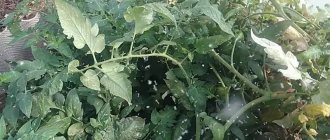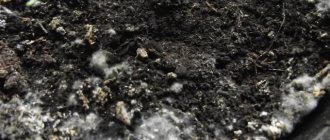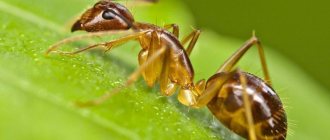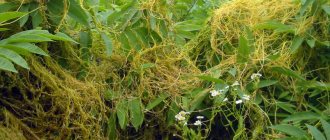About spider mites
Spider mites are arachnid insects that grow to a maximum of 2 millimeters. But usually the size of the baby does not exceed 1 millimeter. As you understand, it is difficult to notice it even with good eyesight. There are orange, red, yellow-green and almost transparent individuals.
Such a tick settles in conditions that are comfortable for it. Usually this is the lower part of the plant leaf, but in the future it can settle in another place.
Prefers to winter:
in small crevices;- on weeds;
- on plant remains.
Insects wake up when it starts to get warmer and the sun warms the air to 10 degrees. Females lay eggs on the underside of a vegetable or weed. Literally a week later, the larvae hatch, which instantly attack the plants and completely drink their juice.
Females show enviable activity - the magazine “Ural Gardener No. 3” for 2016 indicates that on average up to 400 babies can appear at a time. There are about 10–12 such cycles per year. It all depends on the temperature and average humidity in the greenhouse. If nothing is done, you will quickly discover that the entire crop is lost.
Characteristics of the insect
Spider mites are harmful insects whose habitat is houseplants, garden crops, and especially greenhouse plants - due to the favorable temperature for them in greenhouses. It is difficult to fight ticks because they are very small. They cannot be noticed until the leaves become covered with cobwebs and the plants lose their usual appearance: they become lethargic and then dry out completely.
The web is so strong that when sprayed with a spray bottle it is difficult to break. In her cocoons, the female lays up to 400 eggs daily with a life expectancy of 40 to 50 days. This shows the avalanche-like speed at which the number of insects is increasing. In winter, the development process in greenhouses stops, and resumes with the beginning of the season.
The length of the female is from 0.4 to 0.6 mm, the male is even smaller. They have a pale green or amber-yellow color. The young offspring of ticks are six-legged, and after several molts they become eight-legged. The favorable environment for the growth of an individual is 25-30 degrees, and its development ends in 7-8 days. At lower temperatures, this process slows down and lasts up to a month.
The tick belongs to the class of arachnids. Usually it is located on the back side of the leaf, feeding on its juice and eating out many small holes. Dehydration causes leaves to become dry and brittle. Even with minor damage, plant development is suspended, and if measures are not taken to destroy parasites, crops lose their ability to recover, and the process of photosynthesis decreases. Diseased leaves become covered with a thin web, turn yellow and fall off.
The particular harm caused by mites lies in their ability to cause significant damage to plants in a short period of time. Hordes of microscopic parasites attack plants, which become sick and then die. This distinguishes them from other plant pests. Therefore, we have to destroy them using various means.
Why are spider mites dangerous?
The small parasite feeds only on the juice of plants and flowers, so it does not pose a danger to humans. You should not underestimate the baby, as the pest is very voracious. He does not know how to bite, since his oral apparatus is not adapted for this.
The damage is purely economic, since all plants and vegetables planted in the greenhouse are quickly destroyed if protective measures are not taken in time. Again, the insect cannot tolerate diseases dangerous to humans.
How to recognize
- Spider mites leave cobwebs everywhere, which appear on the bottom of the leaves. Usually almost transparent and incredibly thin, so it does not look like the web of classic spiders.
- The second sign is white dots on the leaves. The foliage, even with constant watering, dries out for no reason.
- Third, some subspecies of spider mites can sometimes be seen if you strain your eyes. They have small eight legs and a red body. The tick does not have wings or whiskers.
When clinical cases occur, any person, even with poor eyesight, will notice the mass of swarming mites.
Top Chemicals for 2022
When using drugs from this group, it is important to strictly follow the dosage and number of treatments in accordance with the attached instructions. Chemical agents that destroy ticks are divided into two groups:
- insectoacaricides;
- acaricides.
To effectively get rid of the pest, you should alternate products with different components in the composition. Many products cease to perform their function after repeated treatment.
If you need to use chemicals, you must follow a number of simple but important rules:
- During use, wear long sleeves, gloves and a hat to protect skin, mucous membranes and hair. The best place for spraying chemicals is a balcony, loggia.
- For indoor flowers, choose products with toxicity class 3-4. Highly toxic substances are only suitable for outdoor plants.
- In case of serious infection, it is necessary to carry out not one, but 4 treatments with an interval of 5-7 days.
Examples of chemicals and their use are presented in the table:
| Name | Protection time (days) | Peculiarities |
| Akarin | 8-15 | Provides assistance within 48 hours. Suitable for roses, violets and orchids. |
| Aktara | 14 | It does not have an unpleasant odor, but is considered ineffective against ticks. |
| Aktellik | Toxic, it is better to spray outside. Do not allow it to get into the ground. | |
| Anti-mite | 7-9 | Defeats different types of pests. |
| Apollo | 60-90 | Sterilizes adults. |
| Bi-58 | 21 | Prevents the emergence of new colonies of parasites. |
| Nissan | 50 | The effect is visible after 11 days. |
| Neoron | 10-40 | Can be used at any humidity and air temperature. |
| Omite 30 and 57 | 14 | Available in different dosages. |
| Oberon | 20-25 | Destroys all stages of insects: eggs, larvae, adult females, except males. |
| Sunmite | 30-35 | The impact on masonry is minimal. |
| Skelta | 80-85 | The death of the pests occurs within a week. Requires re-spraying after 8 days. |
| Fitoverm | 20 | Low toxicity, but re-treatment is required. |
Due to the fact that all mites are similar in structure, flower growers use drugs used in veterinary medicine to treat animals, for example, Neostomozan.
For treatment to be effective, it is better to alternate the use of acaricides and water procedures. Plants in large tubs, as well as specimens with curled leaves or curly dense crowns, for example, ficus, are best dipped into a bucket with diluted products, greens side down, for 1-2 minutes.
Sometimes on forums they suggest using Dichlorvos. This should not be done, the product does not help against ticks, but when sprayed in an apartment it is harmful to human health.
Almost everyone has to fight spider mites, which attack vegetable crops in open ground and greenhouses, and also often appear on indoor plants, from time to time. The pest is tiny in size, but can adapt to different living conditions. The only solution is to regularly treat the plants using special means to combat the parasite.
Effective drugs against spider mites will help save flowers in the apartment, protect cucumbers and other vegetable crops in the garden. There are many means available for these purposes. They differ in price, composition and principle of action.
Why do spider mites settle in a greenhouse?
Amateur gardener Yemets Alena talks about 3 popular reasons why spider mites attack a greenhouse:
- Last season you did not remove weeds.
- The purchased seedlings were accidentally infected with parasites.
- You accidentally introduced pests.
If you find a pest in the first year, then it must be destroyed by all means. Without doing this, there is a big risk of only worsening the situation.
What agricultural crops does it settle on?
In the greenhouse, spider mites most like to settle on cucumbers. However, if they are not there, they can also eat:
Tomatoes
Pepper
Eggplant
Melons
All kinds of cereals
The tick can also settle in beds, but it doesn’t particularly like them, because it lives much better in a greenhouse.
Find and destroy
In the film, the title of which sounds the same as the title of this section, the main character struggled with the enemy for a long time.
For the final victory, he needed to draw up a clear military strategy. The summer resident should do the same. Without a strategy, the harvest will go entirely to the winner, the spider mite. If these arachnids spread unhindered, the plants die completely. First you need to find the enemy. And the sooner this is done, the faster the victory will be.
The first sign of a mite infestation is the appearance of yellow dots along the central vein of the leaf. Pests can settle on 190 species of cultivated and wild plants, for example, cucumbers, peppers, eggplants, pumpkins and melons, but they practically never appear on tomatoes. Moreover, greenhouses are attacked more often than open ground.
The appearance of yellow dots on the leaves is a sign of spider mites
After some time, the yellow spots on the leaves increase because the pest pierces the leaf cell and feeds on its juice. A cobweb appears on the back of the sheet, along which uninvited guests move. Then the leaves finally turn yellow and dry out. First, the mites destroy all the leaves, and then they move to the upper part of the plant and eat the fruits and young leaves.
A plant infected with spider mites
Folk remedies
It is best to start fighting ticks using traditional methods. Not only will the plants not suffer from them, but nothing will happen to humans either.
Ammonia
- Fill a bucket of water and pour 30 milliliters of ammonia inside.
- Mix thoroughly.
- Water the stems and leaves regularly.
- Also constantly wipe the walls and doors of the greenhouse with the resulting mixture.
Tomato tops
The tomato tops that remain after harvesting will be an excellent tool in the fight against the pest.
You need to take about 0.5 kg of it and fill it with a bucket of boiling water. Further:
- place the bucket with tops on the stove and boil for 30 minutes;
- strain the resulting mixture;
- add soap shavings to it.
By watering with this mixture, you will get rid of not only ticks. In addition to them, it will be possible to destroy the ubiquitous aphids.
Fumigation
You will have to wait until the end of the summer season - usually this happens in early November.
We will fumigate with sulfur bombs. Further:
harvest the remaining harvest;- water the soil, getting rid of even the tiniest weeds;
- put on a gas mask and protective gloves;
- Moisten the surfaces thoroughly with water;
- place the checkers on stones or metal surfaces and then set them on fire;
- close the door to the greenhouse for several days;
- After this, you need to ventilate the room.
Dry wormwood
Collect a kilogram of wormwood and chop the stems.- Fill the grass with 10 liters of water.
- Cover the container with a lid and keep it out of the sun for 2 days.
- Place the bucket on the fire and wait until it boils.
- The liquid should bubble for ¼ hour.
- Dilute the resulting mixture with a bucket of water and begin spraying the greenhouse plants.
Drugs
If a small number of plants are infected with mites, then it is advisable to use traditional methods of pest control. However, if a harmful insect has infected most of the crops in the greenhouse, then it is necessary to use various chemicals, but their disadvantage is that they negatively affect the crop itself.
You can remove ticks using the following medications:
- Fitoverma - it can be used to spray both seedlings and indoor plants;
- Benzyl benzoate - effectively fights against all types of ticks;
- Bi-58 - should be used if it is not possible to achieve a positive effect by other means;
- Actofita - will show good results if sprayed in clear weather.
Before you start using chemicals, the plants need to be watered thoroughly. This must be done so that the crops experience less stress and do not get burned. To ensure that the results of plant treatment are as good as possible, experienced gardeners recommend adding potassium soap (50 g) to the solution.
Spider mites in a greenhouse.
Chemicals should be sprayed on the plant itself and on the soil. Do not allow the solution to come into contact with the root system.
To prevent crops from dying, it is necessary to maintain the correct concentration of chemicals, so before using the products you should carefully study the manufacturer’s recommendations. You can re-treat after 1.5 weeks, using other drugs.
Chemical methods
If insects cannot be controlled with folk remedies (or you started the fight too late), chemical methods should be used. But you need to use them extremely carefully so as not to damage the plants and not get poisoned yourself.
Plant Pin
It destroys not only adults, but also their eggs.
The drug looks like special sticks. We will poison ticks like this:
- take a stick and stick it into the ground at a distance of 2 centimeters from the stem (this should be done on each plant);
- water the plant.
After this, the plant pin will be absorbed into the ground. Insects will feel the effect of the drug within a few days. Usually they talk about two days, but most often you need at least 3-4 days.
Fitoverm
One treatment is enough for spider mites to immediately stop reproducing. But the remedy is suitable only when there are still few insects.
How to use:
- pour 2 liters of water into a bucket;
- open the ampoule of the drug and mix it in a bucket;
- then pour more water and mix thoroughly again;
- pour the resulting mixture next to the plants.
Aktellik
The drug is poisonous to humans, so you need to wear gloves, a protective mask and a reliable headgear. If possible, wear protective clothing. You can use a robe. When diluting the drug, act only strictly according to the instructions. It is forbidden to deviate from it.
At the same time, Candidate of Agricultural Sciences Tatyana Steinert says that due to its toxicity, the drug is now used mainly in industrial greenhouses.
Actellik is used as follows:
- dilute the drug in a small amount of water;
- bring the emulsion concentration to 1 mm per 1 liter. working solution;
- Apply the resulting solution generously to the plant leaves.
Preparing the greenhouse for pest control
In order to have a good effect from the treatment against ticks, you need to carry out the correct preparatory work:
- remove all plant debris from the greenhouse immediately;
- remove all equipment and watering containers from the greenhouse;
- remove the top layer of soil by 5-7 cm;
- wash the greenhouse with warm water;
- wash all surfaces and frame with a solution of laundry soap or potassium permanganate;
- After the greenhouse has dried, coat the wooden frame with slaked lime, and the metal frame with kerosene.
Prevention of pest occurrence
In addition to means of combating spider mites, comprehensive prevention is also important.
It can be divided into 3 stages:
- in the spring - preparation;
- all season - current;
- before wintering - final.
In the spring, you need to clean the room after wintering and sterilize the soil. For this:
- wash the greenhouse structure with soapy water, after adding chlorine to it;
- dig up the soil to 25-30 cm;
- treat it with boiling water;
- cover the soil tightly with film for 3 days;
- fumigate the room with sulfur bombs;
- spill the soil with a one percent manganese solution.
During ongoing prophylaxis:
- high humidity must be maintained in the greenhouse;
- plant plants at a distance of one and a half meters;
- regularly inspect planted vegetables;
- remove parts of leaves on bushes;
- mulch the soil;
- spray the soil and plants with onion infusion.
Autumn:
- completely remove plant debris and various auxiliary structures;
- Dig the soil carefully, adding lime or phosphate fertilizers.
How to treat a greenhouse
You can say goodbye to the pest once and for all only with a comprehensive confrontation with it. Therefore, I do not forget about processing not only during the season, but before it begins and after it ends.
How to get rid of spider mites in a greenhouse in the spring
In the spring, any greenhouse needs general cleaning and disinfection. I conduct simple traditional events:
- Deep digging of the substrate.
- Disinfection by pouring boiling water. To prolong the effect that is destructive for eggs and larvae of pests, I cover the soil after watering with a thick film. The hot steam will continue to have a derogatory effect.
- Disinfection with manganese solution. I water the greenhouse substrate with a 1% suspension of potassium permanganate.
If ticks settled in the greenhouse last summer, preventative fumigation with a sulfur bomb would not be amiss.
autumn digging in the greenhouse
How to get rid of spider mites in a greenhouse in the fall
At the end of the season, I turn to a simple treatment:
- I remove and destroy all plant remains - tops, roots, fruits.
- I disinfect auxiliary structures - trellises, pegs, garters - with a solution of potassium permanganate.
- I wash the interior surfaces of the greenhouse with a chlorine solution.
- I carry out a deep digging of the earth, having previously scattered lime or phosphate preparations over the ridge. These fertilizers have a negative effect on spider mites.
If arachnids have settled in the greenhouse in the summer, I turn to additional treatment:
- I wash the internal surfaces and glass with a 20% alcohol solution.
- I treat the soil with a solution of colloidal sulfur (100 g per 10 liters of water).
To reach hard-to-reach places, I spray all secluded places and recesses in the greenhouse with disinfectant solutions from a sprayer. All kinds of pests often stay there for the winter.
Signs of a parasite
Most often, the pest enters the greenhouse with young seedlings or through the gardener’s clothing. Less commonly, animals carry it onto plants. At the initial stages of colonization, it is very difficult to notice the presence of a tick. White spots may appear on the leaves, which can easily be confused with some third-party problem, for example, lack of moisture.
After a few days, the markers will begin to turn yellow (especially noticeable on the tomato), and after a week, when the parasites have multiplied, it will be possible to examine each individual individual. Later, a specific web will appear, indicating the development of the colony. Those plants that are located closest to the passages and exits of the greenhouse are most at risk. This suggests that the infection came from the street.
Read more ► Dust mites: how to get rid of them at home, why they are dangerous, elimination in 4 steps
Spider mites suck out plant juices, thereby disturbing the water balance: the leaves are depleted and the stem dries out. But the pest is dangerous only for flora. The parasite cannot cause any significant harm to human health (infect or bite).
Fighting spider mites on flowers
Spider mites on roses
Spider mites on flowers are as common as on vegetables, but of all garden flowers, roses attract the pest the most. Plants that are depleted by improper care primarily fall victim to spider mites: white dots appear on the leaves of roses, and when severely infested, whitish spots appear. Then the leaves turn yellow and fall off, cobwebs appear, and upon closer examination, small moving dots—spider mites—can be seen on the underside of the leaves.
Growing roses - planting and caring for the garden
Since the best fight against diseases and pests is prevention, do not forget to water your roses and carefully inspect the back of the leaves as often as possible, and at the first sign of pests, begin to destroy them. If you miss the moment, then by autumn the number of fertile ticks can increase hundreds of times. Even the arrival of winter will not solve the problem: the mites will safely overwinter in the soil or under leaves and in the spring they will again begin their destructive activities. Therefore, ticks must be destroyed immediately and for sure, using acaricides Neoron, Fitoverm, Actellik and the like. When preparing solutions for treating roses, strictly follow the instructions, since acaricides contain substances that are dangerous to humans and domestic animals.
Fighting spider mites in the orchard
Spider mites on currants
A spider mite that appears on the leaves of black, red or white currants can threaten the complete loss of the berry harvest. If the berries have already set before the mites appear, they are in no danger: the mites will harm the leaves, but will not significantly affect the quantity and quality of the harvest, so you can fight them using folk remedies. Infusions and decoctions of insecticidal plants will do a great job with a small number of spider mites. But if there are a lot of pests and if they appeared before flowering or before the ovary ended, then the ripening of the berries may be at risk.
Growing currants - planting and care in the garden
If you find mites on currants before flowering, feel free to use acaricides to kill the pests. Keep in mind that white and red currants are more vulnerable than black currants. So:
- first remove from the bush and burn absolutely all the leaves damaged by the mite, then water the bushes abundantly, washing away the remaining insects with a strong stream;
- be sure to remove cobwebs, otherwise they will turn into a water-repellent barrier;
- a good result is obtained by spraying the bush with water, if immediately after this you briefly wrap the plant with a film, creating an eighty percent air humidity under it that is unbearable for ticks;
- Place jars of turpentine or ammonia around the bush and cover the bush with film: turpentine and ammonia will quickly kill ticks;
- folk remedies will almost certainly cope with a small number of pests, but if the bush is severely affected, then, without wasting time, start treating the currants with acaricides.
If you notice spider mites on gooseberries, use the same means to control them as you would to control pests on currants, since the two crops are closely related.
Spider mites on grapes
In addition to common spider mites, grapes are damaged by red fruit mites and sometimes hornbeam spider mites. Newly hatched red fruit mite larvae can be seen on the underside of young grape leaves in early spring. The common spider mite first develops on weeds and appears later on grapes. But these types of mites harm grapes in the same way: with their pointed lower jaw they penetrate the cells and absorb their contents, releasing their poisonous saliva into the leaf tissue.
How to grow grapes - planting and care
When grapes are early affected by mites, their leaves practically do not grow and are deformed, often curling, acquiring a light brown color and falling off prematurely. The degree of damage is influenced by the grape variety, nutrition, location of the bush and weather conditions.
- Results of treating the garden with Actofite – does the drug work?
Before the buds open, it makes sense to treat mite-affected grapes with Nitrophen or DNOC, after removing diseased leaves and severely damaged bark. After the start of growth, the plants are treated with Neoron, Fozalon, Akrex, Pliktran, Keltan or Rogor. If the drug has a short period of action, you need to repeat the treatment after 10-12 days. You should know that spider mites are capable of developing resistance to drugs, so when processing, alternate acaricides with different active ingredients.
Spider mites on strawberries
The most dangerous parasites are strawberry mites, especially since they are very difficult to notice. As a result of the activity of mites, the entire berry crop can be destroyed, and at the same time there remains a possibility that, due to mites disrupting the growth of flower buds, problems with the harvest may arise next year. Gardeners have identified the following pattern: the older the strawberry bed, the more damage the pest can cause to it. Ticks are most dangerous for bushes that are 3-4 years old.
Growing strawberries - planting and caring for them
Infection of strawberries with spider mites occurs through seedlings. Pests can enter the area from people's shoes and clothes. Peak population growth occurs in August and September. You can detect mites on strawberries by the following signs:
- the bushes do not develop, small wrinkled leaves with abnormally curly edges appear on them;
- a silvery film forms on the underside of the leaves;
- leaves acquire a yellowish tint;
- the berries do not develop and dry out;
- In winter, the plantation freezes.
When starting to fight mites on strawberries, you should know that they concentrate in places that are difficult to treat, so it will not be possible to completely destroy them. But in order to curb the development of the population and save the harvest, it is necessary to fight spider mites. The best way to destroy the pest is to release predator mites into the area. Biological enemies of ticks can greatly reduce their numbers. After harvesting, you can cover the bushes with plastic film, preventing air from getting under it. When the temperature under the film rises to 60 ºC, remove it and cut off the affected bushes at the root, then cover the bed with humus. You can also use folk remedies, for example, spraying with onion or garlic infusion: once at the very beginning of the growing season and twice after harvesting, each time after treatment, covering the strawberries with film for several hours.
Spider mite on an apple tree
If there is a strong invasion of spider mites, the apple tree may lose up to half of its leaves by mid-summer. As a result, its productivity is significantly reduced. Therefore, as soon as you notice the presence of pests on the tree, begin to decisively combat them. Of the folk remedies, the most effective is tobacco solution, which is used to treat the apple tree twice at intervals of a week. In advanced cases, you will have to spray the apple tree with Nitrophen or Decis twice: after the ovaries appear and a month before harvest. In the fall, you need to remove all fallen leaves and fruits from under the tree, cut out old and diseased branches in which ticks can overwinter, and burn all these plant debris.
Growing apple trees in the garden - planting and care










